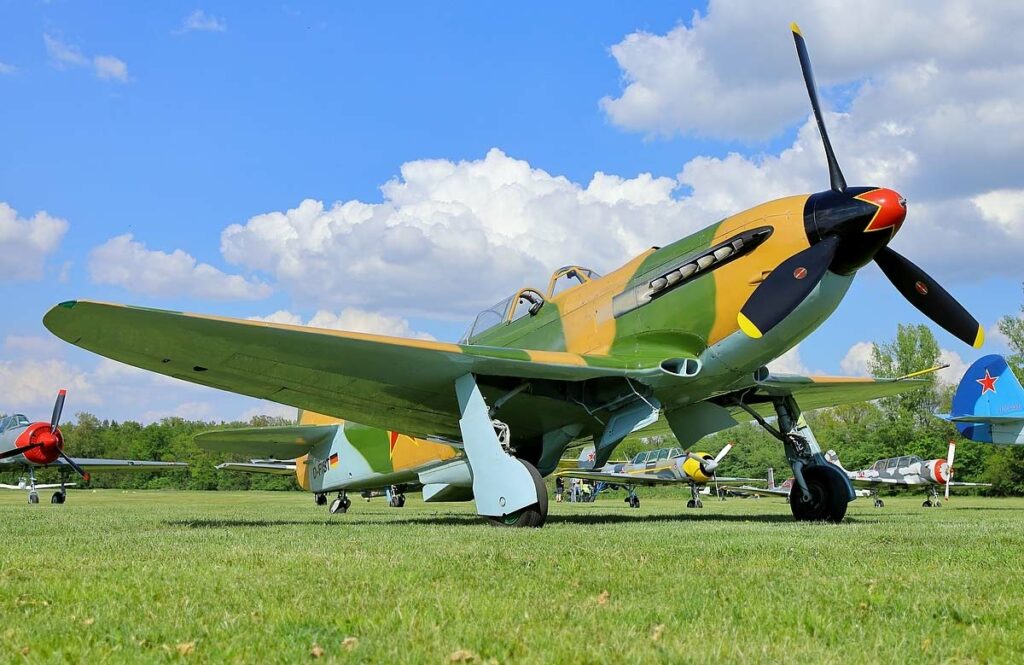The Yakovlev Yak-9, a versatile Soviet WWII fighter and warbird, was known for its balance of speed, maneuverability, and firepower.
The Yakovlev Yak-9 emerged as one of the most important fighter aircraft in the Soviet Air Force during World War II. This article aims to provide a comprehensive overview of the Yak-9’s development, design, performance, and combat history, underlining its role in the Eastern Front battles.
History of the Development of the Yakovlev Yak-9:
In the context of World War II, the Soviet Union needed a high-performance fighter aircraft to counter the advanced German fighters. The Yakovlev Yak-9, developed by the design bureau led by Alexander Yakovlev, was an evolution of the earlier Yak-7.
The development of the Yak-9 was driven by the necessity for an aircraft that could outperform German fighters in various aspects of aerial combat. The program was initiated in the early 1940s, with the first prototype taking to the skies in 1942. This aircraft was designed to improve upon its predecessors in terms of range, firepower, and agility.
Design of the Yakovlev Yak-9:
The Yak-9 featured a lightweight and robust design. It had a length of 8.55 meters (28 feet) and a wingspan of 9.74 meters (31.9 feet). The aircraft’s airframe was constructed primarily from a mix of metal and wood, contributing to its light weight.
Powered by a Klimov VK-105PF2 V-12 liquid-cooled engine, the Yak-9 was designed for agility and versatility. It was typically armed with one 20mm ShVAK cannon and one 12.7mm UBS machine gun, providing a balanced armament for various combat scenarios.
The design of the Yak-9 offered advantages in terms of maneuverability and speed. However, its lighter construction compared to some contemporaries meant it was less robust in certain combat situations.

Performance of the Yakovlev Yak-9:
The Yak-9’s Klimov engine, producing around 1,300 horsepower, enabled a top speed of about 657 km/h (408 mph) and a service ceiling of 10,700 meters (35,105 feet). Its range was approximately 875 kilometers (544 miles), which was significant for tactical flexibility.
Compared to contemporaries like the German Messerschmitt Bf 109 and the American P-51 Mustang, the Yak-9 was competitive, particularly in terms of agility and climb rate, though it fell short in high-altitude performance.
Military Use and Combat of the Yakovlev Yak-9:
The Yak-9’s armament made it effective in air-to-air combat and capable in ground-attack roles. It saw extensive use on the Eastern Front, engaging in dogfights with German fighters and supporting ground operations.
The Yak-9 successfully competed with various German aircraft, often gaining the upper hand in maneuverability and close-quarters dogfighting. It was also used by several Allied nations post-WWII, though its use diminished with the advent of jet fighters.
The Yakovlev Yak-9 was a significant contributor to the Soviet Union’s air efforts during World War II. Its development represented an important advancement in Soviet fighter design, balancing speed, firepower, and maneuverability. In combat, the Yak-9 proved to be a versatile and effective fighter, playing a crucial role in numerous aerial engagements on the Eastern Front. Its legacy in military aviation history highlights the importance of adaptable and well-rounded fighter aircraft in achieving air superiority in large-scale conflicts.
Back to the Warbirds section.